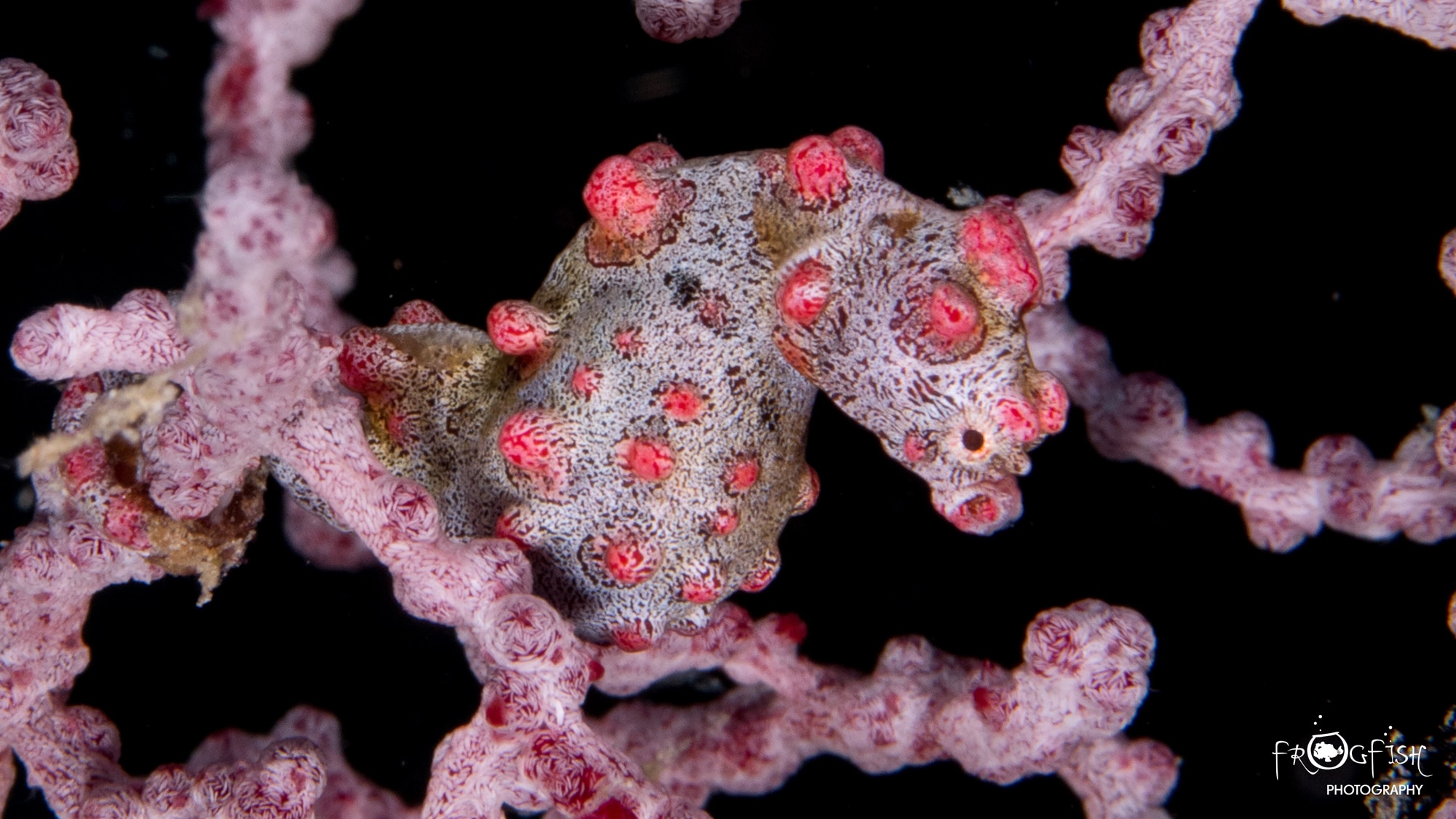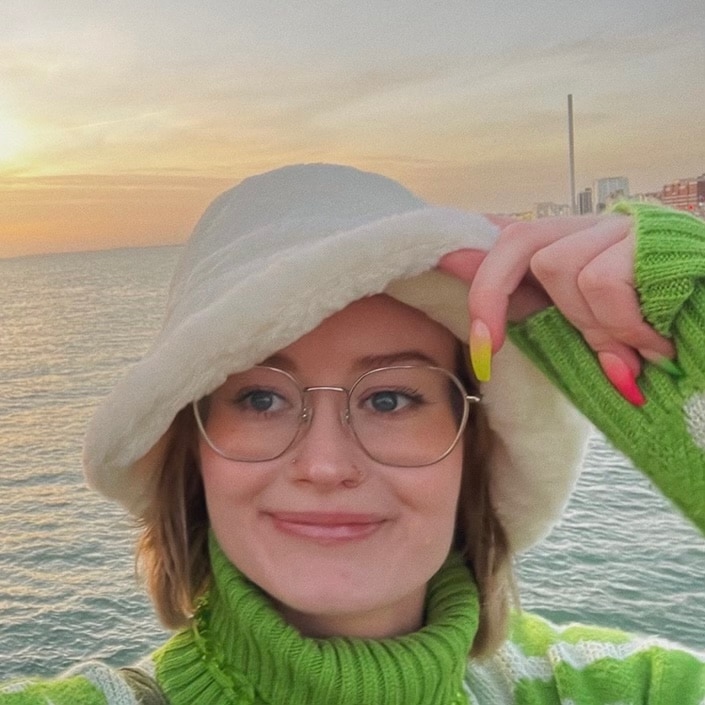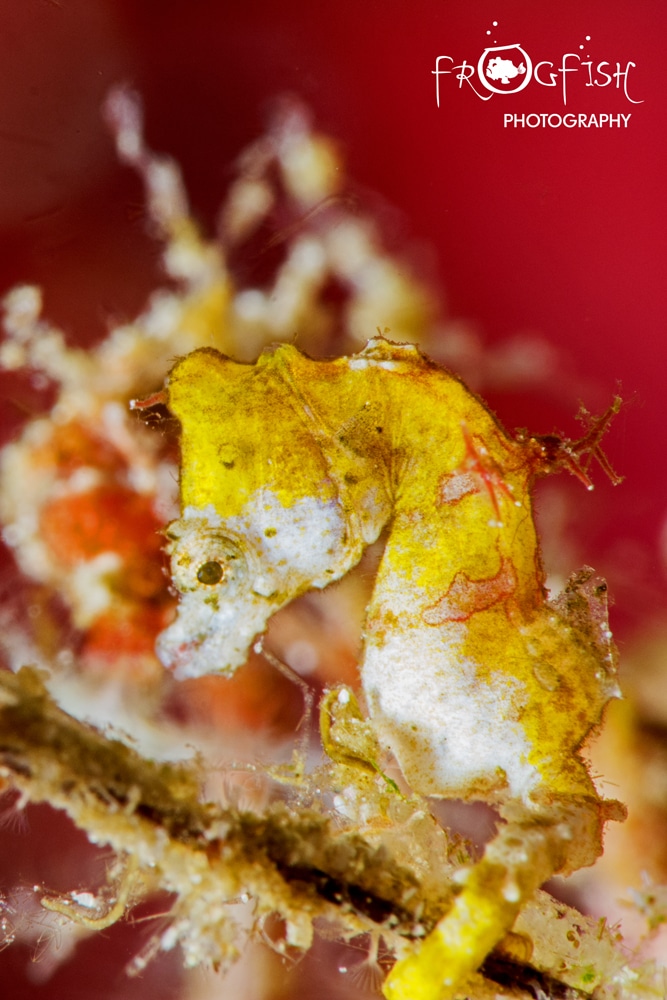Marine Life & Conservation Blogs
Seahorses

A guest blog from Isobel Fairbairn
When I was younger, I’m sure I always wanted to meet a unicorn; maybe one day I still will! Though as I got older, I realised the more interesting (and more likely) horse to come across in the wild is the Seahorse.
Although I haven’t yet had that opportunity besides in the odd aquarium, the best time to go out looking for them would be summer as the warmer months is when they reside in shallower waters, before going deeper into the ocean in winter to avoid the harsher weather. There are approximately 54 species (and counting) varying in size found in different spots all over the world, even recently being spotted in the River Thames!
Seahorses come from the genus Hippocampus, which comes from the Greek Híppokampos, Híppos meaning horse and Kámpos meaning sea monster.
Possibly their most interesting fact is that the male Seahorses are the ones to give birth, being as they’re one of the only species in the world to do this, it’s also possibly the most well-known Seahorse fact! This has its purpose though, as this then frees up the female Seahorse to start making even more eggs.
The males take these eggs from the female, self-fertilise and incubate them, the gestation period can range from 14 days to 14 weeks, then proceed to give birth to baby Seahorses, known as “Frys”. The amount of frys that are produced depends on the species size, ranging from 50-150 babies in smaller species to 1500 in larger species.
Although they be but small, their eyesight is mighty… Seahorses eyes work independently from one another for extra excellent vision, this helps them to hunt and protect themselves. Oddly they also sleep with their eyes open, this is due to the fact they don’t have eyelids. While sleeping they cling onto coral to stop themselves floating away… flying should be left to the unicorns in this case!
As magical as Seahorses may sound, in many cases they, on paper, sound a lot more like monsters than fairy horses, with their complex exoskeleton- fused together with a flesh type covering and a tendency to accidentally eat their own babies… because they look so much like tiny crustaceans (if you ask me, that sounds like an excuse a Seahorse would make up). They can consume up to 3,000 or more brine shrimp a DAY! They manage all that shrimp with no teeth!
We all have weak spots but being a bad swimmer while living in the OCEAN really shows that God does have favourites, sadly for the Seahorse this is indeed the case. These not so strong swimmers use their dorsal fins for power, beating them 30-70 times per second.
Now although not much of that seemed too appealing, Seahorses are still special creatures who need our protection and care. Both species of Seahorse found in the U.K are already protected under the Wildlife and Countryside act (1981). They are at risk all over the world; Chinese medicine take up to 150million Seahorses per year. They are also often snatched from the sea, left to boil in the sun and sold as souvenirs- a horrifying thought.
Seahorses are not exempt from the pet trade either, often caught and sold, then barely surviving in trade conditions for longer than several weeks.
So, remember, if you see a Seahorse in the wild, leave it as untouched as you would a unicorn.
 Isobel Fairbairn is a 22 year old first year Marine Biology student at the university of Salford with a passion for both writing and marine life. “I loves to share things that I learn along my journey and that’s when I decided I wanted to take my career towards writing, I’ve always wanted to write but when my two passions collided I knew I had to go in this direction.”
Isobel Fairbairn is a 22 year old first year Marine Biology student at the university of Salford with a passion for both writing and marine life. “I loves to share things that I learn along my journey and that’s when I decided I wanted to take my career towards writing, I’ve always wanted to write but when my two passions collided I knew I had to go in this direction.”
She lives in Manchester. Her favourite fish is the Chimera Shark and she is currently undergoing her diving training with BSAC with the university’s diving society. “I am equal parts terrified and excited.”
Instagram: @ihf.media
Blogs
Saba’s Plan for a Coral Comeback

Saba has an exciting new initiative to restore its coral reefs. This new project, running from 2024 to 2026, will focus on reviving key species in the island’s underwater ecosystems. With a collaborative team from the Saba Conservation Foundation (SCF) and Van Hall Larenstein (VHL) University of Applied Sciences, the project aims to restore both corals as well as sea urchins.
This initiative is centered around coral restoration, specifically reviving two essential coral species—staghorn coral (Acropora cervicornis) and elkhorn coral (Acropora palmata). By mapping parent colonies and using a technique known as coral gardening, SCF will create and maintain coral nurseries. These corals will eventually be outplanted at key reef sites around Saba to not only expand the number of coral colonies, but also provide essential fish habitat. The project focusses on installing coral nurseries, training staff with the newest techniques and starting with the restoration of key reef sites.

Reef Cleaners to the Rescue
It’s not just corals getting a makeover—this project also shines a spotlight on the essential role of grazers, particularly sea urchins. VHL is leading the charge on cultivating and restocking two key sea urchin species, West Indian sea egg (Tripneustes) and long-spined sea urchin (Diadema), known for their ability to keep algae in check. By removing algae, which are important competitors of corals, they help the coral to thrive. By restoring these “reef cleaners,” Saba’s project will give corals the breathing room they need to grow, setting the stage for a healthier, more balanced marine ecosystem.
From Tiny Urchins to Big Goals
The project will be funded as part of the Dutch Government’s Nature and Environment Policy Plan (NEPP) 2020-2030 for the Caribbean Netherlands, a comprehensive initiative aimed at conserving and restoring the unique natural environments of the Dutch Caribbean islands, including Saba, St. Eustatius, and Bonaire. This project is aiming for big milestones: build and maintaining coral nurseries, the expansion of urchin cultivation facilities, and the creation of a dedicated research center. By 2026, the project hopes to ramp up coral and grazer restoration, with the ultimate goal of extending these efforts across the Dutch Caribbean. By linking local initiatives to broader regional goals, Saba’s restoration project promises to leave a lasting impact on both the environment and the community.
Find out more about the DCNA at dcnanature.org.
Blogs
Reef-World marks two decades of marine conservation: strengthening impact amid coral reef threats

Empowering ocean stakeholders to tackle future challenges and ensure the survival of coral reefs and humanity
2024 marks the 20th Anniversary of The Reef-World Foundation’s tireless efforts for global coral reef conservation. The UK charity is the international coordinator of the UN Environment Programme’s Green Fins initiative, known as the leading voice in sustainable marine tourism. Today, Reef-World released its 2023-2024 Impact Report outlining a year of substantive growth and impact in its marine conservation programmes.

Impact Report Highlights:
- Impressive improvements in environmental behaviours to protect coral reefs by the marine tourism industry as the global participation of Green Fins increases.
- Continued capacity building for government and NGO staff to effectively manage marine tourism activities in Asia, Caribbean and Red Sea regions.
- For the first time in Green Fins’ 20-year history, tourism operators have achieved ‘Best Environmental Performer’ status by demonstrating the lowest possible environmental impact in their environmental assessments. In 2024, three dive operators achieved this challenging milestone.
- Significant increases in global participation of Reef-World’s innovative digital conservation tools.
- 138 Green Fins dive operator members achieved the strict threshold for PADI Eco Center recognition.
- Developed four new educational materials and translated two into 16 languages to support the marine tourism industry in achieving sustainability targets.
- Establishing a new Reef-World Development strategy and recruiting new roles – Development and Programmes Managers.
- Reef-World’s board welcomes new Chair and Trustees strengthening organisational leadership.

Reef-World started as a one-person mission to inspire and empower communities to act in conserving and sustainably developing coral reefs and related ecosystems. Today, the team of 12 continues to meet this mission by inspiring and empowering the global marine tourism community to be exemplary sustainability leaders by using the Green Fins guidelines and tools to simultaneously use and protect the world’s precious reefs.
In April 2024, the fourth global coral reef bleaching event was confirmed. Reef-World’s work has never been more urgent as the marine environment, and the benefits they provide humanity, continue to be eroded by global threats. The reduction of local threats, like those from the marine tourism industry, is an essential step to ensuring a future where coral reefs survive and continue to support the millions of people who depend on their ecosystem benefits. Reef-World’s work buys time for coral reefs and related ecosystems to be resilient to the impacts of global threats.
“Right now our corals are facing the greatest fight of their existence as the terrifying predictions of the steps towards their complete extinction are starting to come true. But all is not lost, reefs are resilient and they have existed on this planet for millions of years. We must take action now, to buy time for reefs by reducing threats facing them and allowing them to react and adjust to the changing environment they need to survive in.” – Chloe Harvey, Executive Director
Looking Forwards:
Like coral reefs, the Reef-World team needs to be resilient in the face of the complex challenges of the conservation sector. Reef-World has invested significantly in developing a Culture of Care to ensure the well-being of its team on a daily basis, continuing to be an exemplary employer to enable its team to best achieve the mission for coral reef conservation.
With the foundations of a Culture of Care and organisational development laid, Reef-World is emerging from the end of a natural organisation life cycle, that brings the challenges of growth and scale, stronger than ever. With a new strategy in place to generate much needed resources, Reef-World is excited for the opportunities to leap forward, continue to scale our impact and lean into new innovations and untapped opportunities for marine conservation.
We continually strive to become a forward-thinking organisation that delivers on our goals and commitments to our stakeholders with fresh approaches and not being afraid of steering away from a “normal approach.” This approach is not only applied to our programmes of work but also internally and carries over to our Culture of Care for our team.” — JJ Harvey, Operations Director

The Reef-World Foundation is immensely grateful for the continued support of its grant funders: UN Environment Programme, IUCN’s Blue Natural Capital Financing Facility, Adventure Travel Conservation Fund, PADI Aware Foundation, and World Nomads Footprints Program.
Reef-World would also like to express its gratitude to international partners whose vital support has resulted in significant tangible benefits for our work and mission: PADI; Professional SCUBA Schools International (PSS); Explorer Ventures; 1% for the Planet; ZuBlu; Snorkel Venture, GSTC; Dive O’Clock; Seven Dragons; DiveAssure and Eco Beach, without whom these achievements would not be possible.
The full 2023–2024 Annual Impact Report is available on Reef-World’s website.
-

 News2 months ago
News2 months agoIconic SS United States to become the World’s Largest Artificial Reef
-

 News3 months ago
News3 months agoBook Review – 52 Assignments: Underwater Photography
-

 Gear News3 months ago
Gear News3 months agoDYNAMICNORD – New German diving brand enters the British market
-

 News3 months ago
News3 months agoExploring Cenote El Pit: A Diver’s Dream
-

 Gear News3 months ago
Gear News3 months agoTry BARE drysuits (and maybe even win one!) this Friday with Sea & Sea at North West Dive Fest
-

 Marine Life & Conservation3 months ago
Marine Life & Conservation3 months agoBook Review: Coral Triangle Cameos
-

 Blogs2 months ago
Blogs2 months agoDive the Egyptian Red Sea this Autumn with Regaldive
-

 News3 months ago
News3 months ago2024 Ocean Art Underwater Photo Competition Announced
















